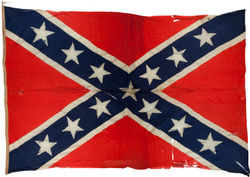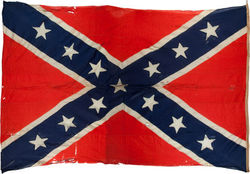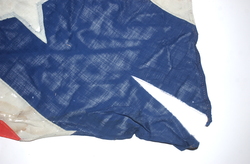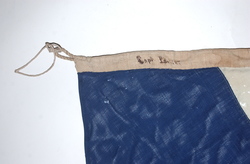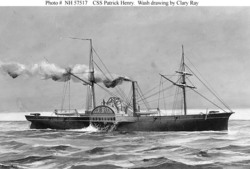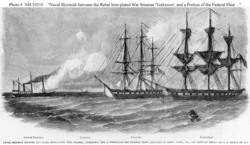Jack of the CSS Patrick Henry, CS Navy School Ship, Captain William Harwar Parker.
This large wool flag is the 1863 - 1865 jack of the Confederate States Navy (C.S.N.). According to the Table of Allowances for C.S.N. a jack with a hoist of 8' would have been styled as a No. 3 Jack, the third largest of the eight jacks specified for the C.S.N.
This jack was a special usage maritime flag of national character representing Confederate nationality and generally flown on the jack staff in the bow of vessels. However, in the 19th century the jack could be displayed at various locations on the ship as a special signal, such as at the foremast to call for a pilot or at the starboard spreader to indicate that a Captain's Mast (a general court martial or a court of inquiry) had been convened or in the bows of small boats to indicate that chief of a C.S. diplomatic mission is officially embarked in the waters of the country to which he was accredited.
This jack is inscribed "Capt. Parker." A review of the roll of the commissioned officers of the C.S.N. reveals only three officers with the surname Parker. One, J.H. Parker was a 2nd Assistant Engineer, ranking equivalent to a master (on modern terms an ensign, the lowest grade of commissioned officer); another C.M. Parker was a Passed Assistant Surgeon, ranking equivalent to a lieutenant, leaving only First Lieutenant W.H. Parker as a serving as a line officer.
This is a reference to William Harwar Parker, a distinguished American naval officer, who unlike his brother William Foxhall Parker threw his lot in with the South when he resigned his commission in the US Navy (U.S.N.) and joined the briefly extant Virginia State Navy in 1861. That organization transferred to the nascent C.S.N. in June of 1861, and Parker was commissioned a lieutenant and on 9 September 1861 assumed command of the gunboat CSS Beaufort, captaining her in the battles of Roanoke Island February 7-8, 1862 and Hampton Rhodes 8-9 March 1862.
In May of 1862 Lt. Parker was transferred to shore duty, and participated in the 15 May Battle of Drewy's Bluff. In September of 1863 he was appointed First Lieutenant and Executive Officer of the CSS Palmetto State in Charleston, SC, a position he retained until October of 1863 when he was made the Captain/Superintendent of the Confederate States Naval Academy, based aboard the CSS Patrick Henry, James River Squadron, home-ported in Richmond, VA.
Parker was a natural choice, he was a scholar-sailor, having both graduated from, and later been a professor of mathematics, navigation and astronomy at the United States Naval Academy at Annapolis, MD. While superintending the CS Naval Academy he also briefly (May to June 1864) was the captain of the CSS Richmond, an ironclad also attached to the James River Squadron. Captain Parker duties as superintendent were often interrupted by the war and often classes for the midshipmen were suspended when the CSS Patrick Henry was called to wartime duties.
In 1865 when the Confederate government abandoned Richmond, Captain Parker and the CS midshipman of the Confederate Naval Academy were entrusted with safeguarding the Confederate Treasury and Archives while it was transferred to the new seat of government in Danville, VA. The Confederate midshipmen were entrusted with the gold in the Confederate Treasury and after successfully performing their duty; each of the midshipmen was rewarded with $40.00 in gold.
Of the three ships on which Captain Parker served, only the CSS Patrick Henry is thought to have been large enough to wear a jack of this size. It is surmised that when Captain Parker and the midshipmen quit the school ship on 3 April 1865, burning her to prevent capture, he retained this jack for safekeeping. In the United Kingdom's Royal Navy the jack was equal in size to the canton of the ensign displayed by as warship. This was the case in the 19th century and remains the practice to the present day. The U.S.N. and C.S.N. both maintained this tradition, and that would indicate that the corresponding ensign of the CSS Patrick Henry was a No. 2 ensign approximately 16'10' on the hoist and 32' on the fly, far too large to be carried ashore, or used on land except from a free standing flagpole. The jack, though also large, was the logical choice for Captain Parker and the midshipman to take with them. At some point he inscribed the jack in ink, "Capt. Parker", the only surnamed parker to attain the title "Captain" in the Confederate Navy.
After the war W.H. Parker served as the captain of Pacific Mail steamship, the president of the Maryland Agricultural College, and briefly served as the U.S. Minister to Korea. He died in Washington D.C. at the age of 70 on 30 December 1896.
ZFC Significant Flag
Provenance:
• Confederate States Navy, 1863-1865.
• Captain William Harwar Parker, Superintendent of the Confederate States Naval Academy, until 1865.
• Retained as a memento of service by Capt. Parker, until passing 1896.
• By descent in family until sold at estate Auction.
• Acquired by Brooks Militaria, Montgomery Alabama, until 2010.
• Sold via Heritage Auctions, Dallas TX, to Zaricor Flag Collection in 2011.
Sources:
Scharf, John Thomas, History of the Confederate States Navy from its organization to the surrender of its last vessel, Rodgers & Sherwood, New York, 1887.
William Harwar Parker, Wikipedia, 1 June 2012, from: http://en.wikipedia.org/wiki/William_Harwar_Parker
Union Jack, Sea Flags, 1 June 2012, from: http://mysite.verizon.net/vzeohzt4/Seaflags/ensign/Ensign.html#jack
Madaus, Howard Michael, Confederate Flags at Sea, Flags of the Confederacy, 1 June 2012, from: http://www.confederate-flags.org/Confederate%20Flags%20At%20Sea-6.html
Preble, George Henry, The History of the Flag of the United States of America. Boston, Houghton, Mifflin & Co., 1894.
Image Credits:
Zaricor Flag Collection
Heritage Auction, Inc.
Fonda Thomsen, L.L.C.


